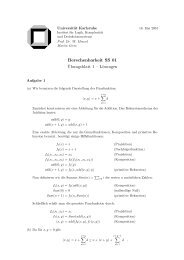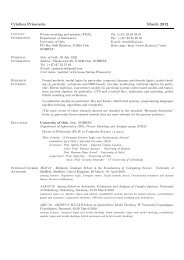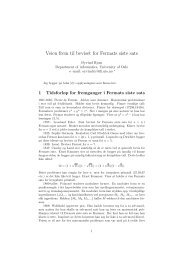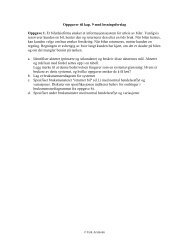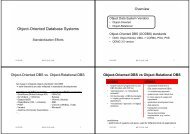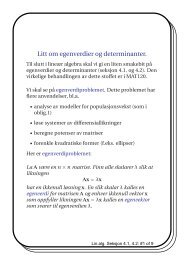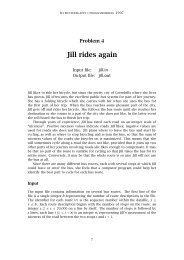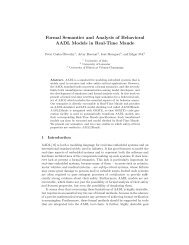Timed CTL Model Checking in Real-Time Maude⋆ - IfI
Timed CTL Model Checking in Real-Time Maude⋆ - IfI
Timed CTL Model Checking in Real-Time Maude⋆ - IfI
You also want an ePaper? Increase the reach of your titles
YUMPU automatically turns print PDFs into web optimized ePapers that Google loves.
26 D. Lepri, E. Ábrahám, and P. Cs. Ölveczky<br />
– ϕ = E ϕ1 UI ϕ2: We need to show both implication directions.<br />
“⇐”: Assume T K gcd , t |=p ϕ. By def<strong>in</strong>ition<br />
T K gcd , t |=p ϕ iff there exists π ∈ tfPathsT Kgcd(t) and an <strong>in</strong>dex j s.t. dπ j ∈ I,<br />
T K gcd , t π j |=p ϕ2, and ∀ 0 ≤ i < j T K gcd , t π i |=p ϕ1.<br />
Let π be such a path and j such an <strong>in</strong>dex. Note that all tick steps <strong>in</strong> π have<br />
duration ¯r/2.<br />
This path π is also <strong>in</strong> tfPaths T K(t). We show that for each time ref<strong>in</strong>ement<br />
π ′ ∈ tfPathsT K(t) of π there is an <strong>in</strong>dex j ′′ s.t. dπ′ j ′′ ∈ I, T K, tπ′ j ′′ |=c ϕ2, and<br />
T K, t π′<br />
i |=c ϕ1 for all 0 ≤ i < j ′′ .<br />
Let π ′ ∈ tfPaths T K(t) be a time ref<strong>in</strong>ement of π. Then t π j<br />
also appears <strong>in</strong><br />
π ′ at the same time po<strong>in</strong>t dπ j at some <strong>in</strong>dex j′ , i.e., dπ′ j ′ ∈ I. By <strong>in</strong>duction<br />
T K, t π j |=c ϕ2 and from t π j<br />
dπ j is a multiple of ¯r/2 we have that dπ′ j ′ = dπj Let π0 be the concatenation of πpre and π ′ . Then tπ′ = tπ′ j ′ we get T K, tπ′ j ′ |=c ϕ2. Furthermore, s<strong>in</strong>ce<br />
is also a multiple of ¯r/2.<br />
j ′ appears <strong>in</strong> π0 at position<br />
n0 + j ′ and time po<strong>in</strong>t d π0<br />
n0+j ′. If dπ0<br />
n0+j ′ is a multiple of ¯r then we def<strong>in</strong>e<br />
j ′′ = j ′ . Otherwise let d π0<br />
n0+j ′ be <strong>in</strong> the time <strong>in</strong>terval (n¯r, (n + 1)¯r) for some<br />
n ∈ N0. Let j ′′ be the smallest <strong>in</strong>dex such that d π0<br />
n0+j ′′ ∈ (n¯r, (n + 1)¯r). Then<br />
by Lemma 1 we conclude from T K, tπ′ j ′ |=c ϕ2 and tπ′ ′ = tπ0 ′ that also<br />
T K, t π0<br />
n0+j ′′ |=c ϕ2, i.e., T K, t π′<br />
j ′′ |=c ϕ2.<br />
j<br />
n0+j<br />
Similarly, by <strong>in</strong>duction we get that T K, t π′<br />
i |=c ϕ1 for all i < j ′′ <strong>in</strong> case d π′<br />
i is<br />
a multiple of ¯r/2, s<strong>in</strong>ce these states also appear <strong>in</strong> π at the same time po<strong>in</strong>ts<br />
and they satisfy ϕ1 <strong>in</strong> the po<strong>in</strong>twise semantics by assumption.<br />
For the other states t π′<br />
i <strong>in</strong> π ′ appear<strong>in</strong>g before the <strong>in</strong>dex j ′′ we use the<br />
concatenation π0 of π pre and π ′ to show that they satisfy ϕ1 us<strong>in</strong>g Lemma 1.<br />
Note that those states t π′<br />
i all appear <strong>in</strong> π0 <strong>in</strong> some time <strong>in</strong>terval (n¯r, (n+1)¯r).<br />
Furthermore, <strong>in</strong> this <strong>in</strong>terval there is also a state tmid at the time po<strong>in</strong>t<br />
n¯r + ¯r/2, for which we have already shown that T K, tmid |=c ϕ1. Thus by<br />
Lemma 1 and us<strong>in</strong>g the path π0, also t π′<br />
i satisfies ϕ1.<br />
“⇒”: Assume T K, t |=c E ϕ1 UI ϕ2. By def<strong>in</strong>ition<br />
T K, t |=c E ϕ1 UI ϕ2 iff there is a path π ∈ tfPaths T K(t) s. t. for each time<br />
ref<strong>in</strong>ement π ′ ∈ tfPaths T K(t) of π there is an <strong>in</strong>dex<br />
j ′ s.t. dπ′ j ′ ∈ I, T K, tπ′ j ′ |=c ϕ2, and ∀ 0 ≤ i < j ′<br />
T K, t π′<br />
i |=c ϕ1.<br />
Let π be such a path. Let π ′ be a time ref<strong>in</strong>ement of π <strong>in</strong> which a state<br />
appears at all time po<strong>in</strong>ts n¯r/2 for n ∈ N0. By the above def<strong>in</strong>ition we<br />
conclude that there is an <strong>in</strong>dex j ′ such that dπ′ j ′ ∈ I, T K, tπ′ j ′ |=c ϕ2, and<br />
T K, t π′<br />
i |=c ϕ1 for all 0 ≤ i < j ′ .<br />
Next we def<strong>in</strong>e an <strong>in</strong>dex j ′′ satisfy<strong>in</strong>g the same conditions as j ′ but addi-<br />
tionally such that d π′<br />
j<br />
′′ is a multiple of ¯r/2. If dπ′ j<br />
then let j ′′ = j ′ . Otherwise let aga<strong>in</strong> π0 be the concatenation of πpre and π ′ .<br />
′′ is already a multiple of ¯r/2



